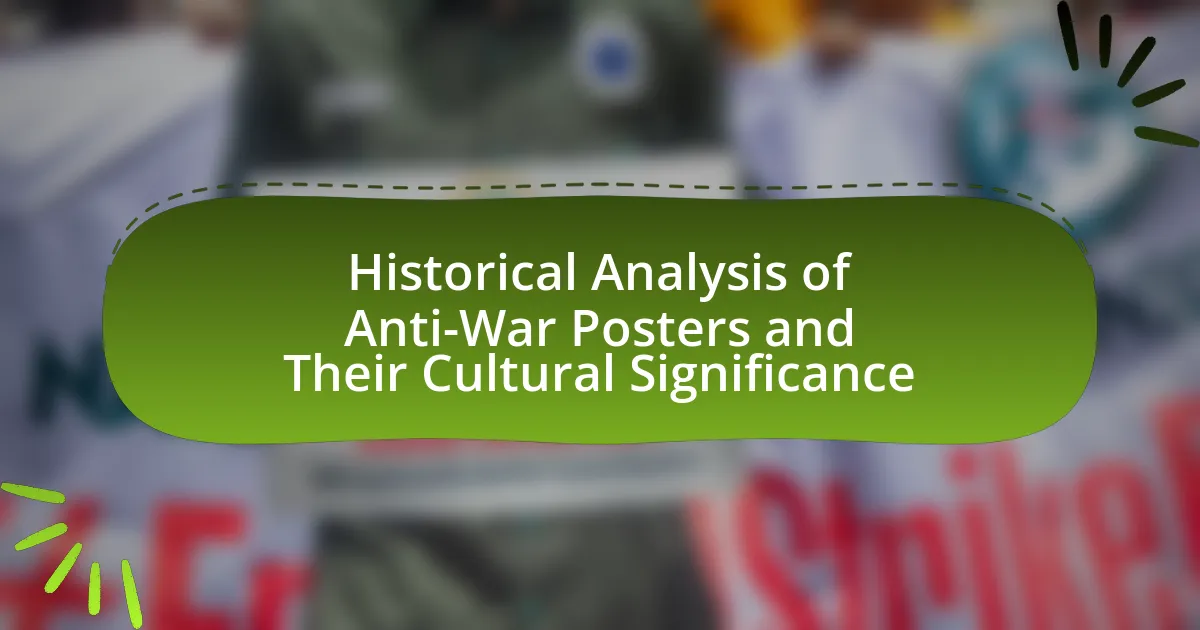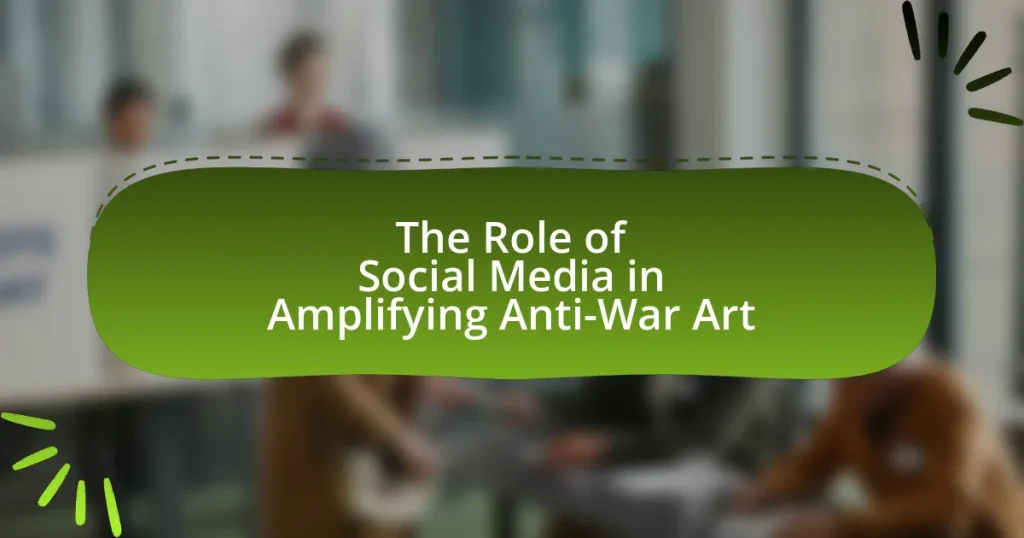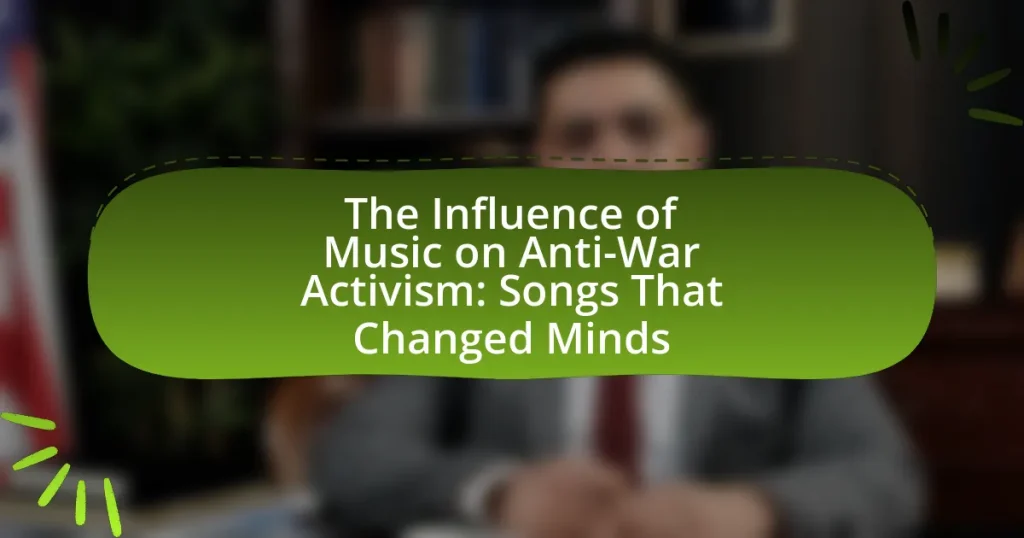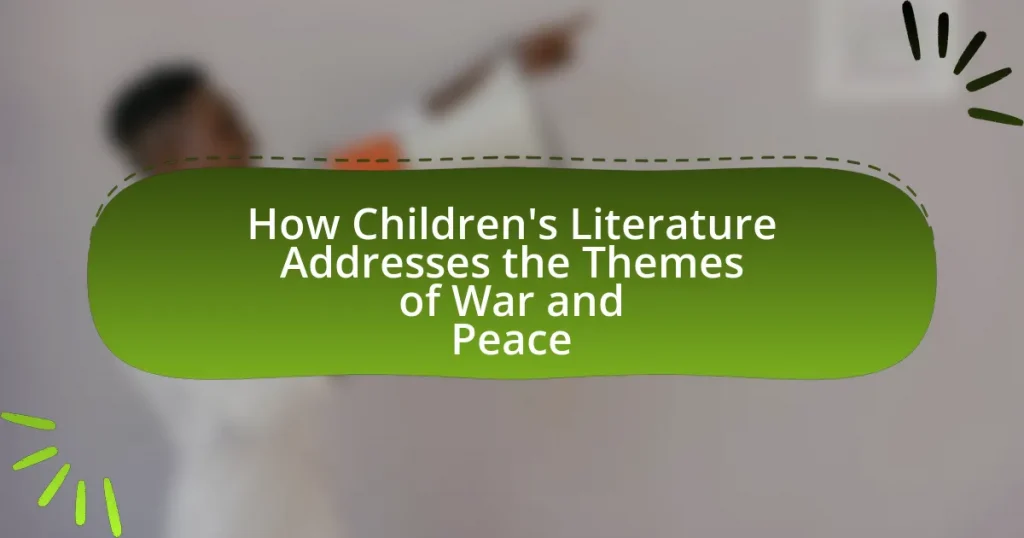Anti-war posters are visual artworks that express opposition to war and advocate for peace, prominently emerging during significant conflicts such as World War I, World War II, and the Vietnam War. These posters have historically served as tools for political activism, shaping public opinion and mobilizing grassroots movements through powerful imagery and slogans. Key themes in anti-war posters include peace, the human cost of war, and social justice, often conveyed through striking visuals and symbols. The evolution of these posters reflects changing societal attitudes and technological advancements, with contemporary anti-war activism increasingly utilizing digital platforms to enhance outreach and engagement. This article provides a historical analysis of anti-war posters, examining their cultural significance, the artists and activists involved, and the impact of visual elements on public perception and policy.

What are Anti-War Posters and Their Historical Context?
Anti-war posters are visual artworks created to express opposition to war and promote peace, often featuring powerful imagery and slogans. Historically, these posters emerged prominently during conflicts such as World War I, World War II, and the Vietnam War, serving as tools for political activism and social commentary. For instance, during the Vietnam War, the “Make Love, Not War” slogan became iconic, encapsulating the counterculture movement’s rejection of military engagement. The use of anti-war posters has played a significant role in shaping public opinion and mobilizing grassroots movements, as evidenced by the widespread distribution of such materials during the 1960s and 1970s, which contributed to the eventual withdrawal of U.S. troops from Vietnam.
How did anti-war posters emerge as a form of protest?
Anti-war posters emerged as a form of protest during the 20th century, particularly in response to conflicts such as World War I and the Vietnam War. These visual artworks served as powerful tools for conveying dissent and mobilizing public opinion against military actions. The rise of mass media and printing technology facilitated the widespread distribution of these posters, allowing activists to reach larger audiences. For instance, during the Vietnam War, organizations like Students for a Democratic Society utilized posters to communicate anti-war sentiments, effectively influencing public discourse and contributing to the broader peace movement.
What historical events prompted the creation of anti-war posters?
The creation of anti-war posters was prompted primarily by the Vietnam War, which escalated in the 1960s and sparked widespread public dissent. This conflict led to significant protests and movements advocating for peace, as many Americans opposed U.S. involvement due to the war’s high casualty rates and perceived moral implications. Additionally, the World War I and World War II eras also saw the emergence of anti-war sentiments, particularly in response to the devastating impacts of these global conflicts. The anti-war movement during the Vietnam War, characterized by iconic imagery and slogans, was particularly influential in shaping public opinion and mobilizing activism against military engagement.
Who were the key artists and activists involved in this movement?
Key artists and activists involved in the anti-war movement included Peter Max, who created iconic psychedelic posters, and Barbara Kruger, known for her provocative text-based art. Additionally, the activist group Artists Against the War featured numerous contributors who used visual art to express dissent against military actions, particularly during the Vietnam War era. Their works often combined striking imagery with powerful messages, effectively mobilizing public sentiment against war. For instance, the “Make Love Not War” slogan, popularized by artists and activists alike, became a cultural touchstone of the movement, illustrating the intersection of art and activism in advocating for peace.
What themes are commonly represented in anti-war posters?
Common themes represented in anti-war posters include peace, the human cost of war, anti-militarism, and social justice. These themes are often depicted through imagery and slogans that evoke emotional responses, highlighting the suffering caused by conflict and advocating for non-violent solutions. For instance, during the Vietnam War, posters frequently illustrated the devastating impact on civilians, emphasizing the loss of life and the destruction of communities. Historical examples, such as the iconic “Make Love, Not War” slogan, encapsulate the counterculture movement’s call for peace and love over violence. Additionally, anti-war posters often critique government policies and military actions, reflecting a broader societal desire for accountability and change.
How do visual elements convey messages in anti-war posters?
Visual elements in anti-war posters convey messages through symbolism, color, and composition, effectively communicating opposition to war. For instance, the use of stark imagery, such as broken weapons or grieving figures, evokes emotional responses that highlight the human cost of conflict. Colors like red can symbolize bloodshed and urgency, while black often represents mourning or despair. Additionally, the arrangement of elements can guide the viewer’s eye and emphasize key messages, such as the juxtaposition of peaceful imagery against violent backgrounds. Historical examples, such as the “Make Love, Not War” campaign during the Vietnam War, illustrate how these visual strategies mobilized public sentiment against military engagement, making the messages more impactful and memorable.
What symbols and imagery are frequently used in these artworks?
Anti-war posters frequently utilize symbols such as doves, peace signs, and broken weapons to convey their messages. Doves represent peace and hope, while peace signs are universally recognized as symbols of anti-war sentiment. Broken weapons symbolize the futility of war and the desire for disarmament. These symbols are often accompanied by imagery of suffering civilians, which highlights the human cost of conflict. The consistent use of these elements across various anti-war artworks reinforces their cultural significance in advocating for peace and social justice.
Why are anti-war posters significant in cultural history?
Anti-war posters are significant in cultural history because they serve as powerful visual tools for social and political commentary, influencing public opinion and mobilizing movements against conflict. These posters emerged prominently during major conflicts, such as World War I and the Vietnam War, where they encapsulated the sentiments of dissent and resistance. For instance, the iconic “Make Love, Not War” poster from the 1960s became emblematic of the anti-Vietnam War movement, reflecting a broader cultural shift towards peace and countercultural values. The effectiveness of these posters lies in their ability to convey complex messages quickly and memorably, often using striking imagery and slogans that resonate emotionally with viewers. This visual rhetoric has historically galvanized communities, contributing to significant political changes and shaping societal attitudes towards war and peace.
How have anti-war posters influenced public opinion and policy?
Anti-war posters have significantly influenced public opinion and policy by visually conveying dissent and mobilizing grassroots activism. During the Vietnam War, for instance, posters like “Make Love, Not War” became iconic symbols of the anti-war movement, effectively swaying public sentiment against military involvement. Research indicates that these visual messages reached diverse audiences, fostering a collective identity among protesters and increasing pressure on policymakers. The widespread distribution of such posters contributed to a decline in support for the war, ultimately influencing legislative actions, including the War Powers Act of 1973, which aimed to limit presidential military authority.
What role do anti-war posters play in contemporary social movements?
Anti-war posters serve as powerful visual tools in contemporary social movements by effectively communicating dissent and mobilizing public opinion against military conflicts. These posters encapsulate complex messages in a concise format, making them accessible and impactful for a wide audience. For instance, during the Iraq War, posters featuring stark imagery and slogans like “No Blood for Oil” galvanized protests and highlighted the perceived motivations behind the conflict. Research indicates that visual activism, including the use of posters, enhances engagement and fosters a sense of community among activists, as evidenced by the significant turnout at events organized around such imagery. Thus, anti-war posters play a crucial role in shaping narratives, raising awareness, and inspiring collective action within contemporary social movements.

How have Anti-War Posters Evolved Over Time?
Anti-war posters have evolved significantly over time, reflecting changing societal attitudes and technological advancements. Initially, during World War I, posters primarily utilized patriotic imagery and slogans to encourage enlistment and support for the war effort. As public sentiment shifted during the Vietnam War, anti-war posters began to adopt more direct and confrontational messages, often employing stark imagery and emotional appeals to highlight the human cost of conflict. The rise of graphic design and print technology in the 1960s allowed for more creative and impactful designs, such as the iconic “Make Love, Not War” poster by David Byrd. In contemporary times, anti-war posters have expanded to include digital formats and social media campaigns, utilizing viral imagery and hashtags to reach broader audiences. This evolution illustrates how anti-war messaging adapts to cultural contexts and technological changes, maintaining relevance in ongoing discussions about war and peace.
What changes have occurred in the design and messaging of anti-war posters?
The design and messaging of anti-war posters have evolved significantly from the early 20th century to the present day. Initially, anti-war posters featured bold graphics and straightforward slogans aimed at mobilizing public sentiment against specific conflicts, such as World War I and the Vietnam War. For example, the “I Want You” poster by James Montgomery Flagg, while a recruitment tool, was later repurposed in anti-war contexts to critique militarism.
In contrast, contemporary anti-war posters often utilize digital art and social media platforms to reach broader audiences, incorporating more nuanced and emotional messaging. Modern designs frequently emphasize personal stories, human suffering, and the consequences of war, as seen in campaigns like “Not in My Name,” which focus on individual responsibility and moral opposition to war.
The shift from simplistic, direct messages to complex narratives reflects changes in public perception and the political landscape, with a greater emphasis on intersectionality and global solidarity. This evolution is supported by the rise of grassroots movements and the influence of technology, allowing for more diverse voices and artistic expressions in anti-war activism.
How did technological advancements impact the production of anti-war posters?
Technological advancements significantly enhanced the production of anti-war posters by enabling faster, more efficient printing methods and broader distribution. The introduction of lithography in the 19th century allowed for high-quality, mass-produced images, which made it easier for activists to disseminate their messages widely. Additionally, the development of digital printing in the late 20th century further revolutionized poster production, allowing for quick turnaround times and the ability to create intricate designs at lower costs. This accessibility empowered grassroots movements, as seen during the Vietnam War era, where posters became a vital tool for protest and public awareness, illustrating the power of technology in amplifying anti-war sentiments.
What shifts in societal attitudes are reflected in the evolution of these posters?
The evolution of anti-war posters reflects significant shifts in societal attitudes towards war, peace, and activism. Initially, early posters often glorified military service and national pride, aligning with prevailing sentiments during conflicts like World War I and II. As societal awareness grew, particularly during the Vietnam War era, posters began to emphasize anti-establishment sentiments, highlighting the futility of war and advocating for peace. This shift is evidenced by the transition from patriotic imagery to more critical representations, such as the use of stark visuals and slogans that questioned government narratives. The rise of grassroots movements and the counterculture of the 1960s further influenced this evolution, showcasing a collective demand for social justice and human rights, as seen in the iconic “Make Love, Not War” slogan. Thus, the evolution of these posters illustrates a broader societal transformation from acceptance of war to a more critical and activist stance against it.
How do different cultures interpret anti-war messages?
Different cultures interpret anti-war messages through their unique historical contexts, values, and social norms. For instance, in Western cultures, anti-war messages often emphasize individual rights and the moral implications of war, reflecting a historical focus on personal freedom and civil liberties, as seen in the protests against the Vietnam War. In contrast, Eastern cultures may interpret these messages through a lens of collective harmony and social responsibility, often highlighting the impact of war on community and family structures, as evidenced by the anti-war sentiments during the Iraq War in countries like Japan, which has a pacifist constitution rooted in its post-World War II history. These interpretations are shaped by cultural narratives, historical experiences, and the prevailing political climate, demonstrating that anti-war messages resonate differently across cultural landscapes.
What are some notable international examples of anti-war posters?
Notable international examples of anti-war posters include the “Make Love, Not War” poster from the United States during the Vietnam War, which became an iconic symbol of the peace movement. Another significant example is the “War is Over! (If You Want It)” poster by John Lennon and Yoko Ono, which was part of their campaign against the Vietnam War in the late 1960s. In Europe, the “Stop the War” poster from the UK, created during the Iraq War protests in the early 2000s, effectively mobilized public sentiment against military intervention. Additionally, the “No More War” poster from the Spanish Civil War era highlighted the anti-fascist sentiment and the broader struggle against militarism. These posters not only served as visual protest tools but also reflected the cultural and political contexts of their times, influencing public opinion and activism.
How do cultural contexts shape the effectiveness of anti-war imagery?
Cultural contexts significantly shape the effectiveness of anti-war imagery by influencing how messages are perceived and interpreted by different audiences. For instance, during the Vietnam War, anti-war posters in the United States utilized symbols and language that resonated with the counterculture movement, such as peace signs and vibrant colors, which effectively mobilized public sentiment against the war. Research by historian David Greenberg highlights that the cultural backdrop of the 1960s, characterized by a growing distrust of government and a strong push for civil rights, made such imagery particularly impactful. In contrast, in cultures where nationalism is prevalent, anti-war imagery may be less effective, as patriotic sentiments can overshadow anti-war messages. Thus, the cultural environment dictates the reception and influence of anti-war imagery, shaping its overall impact on public opinion and activism.
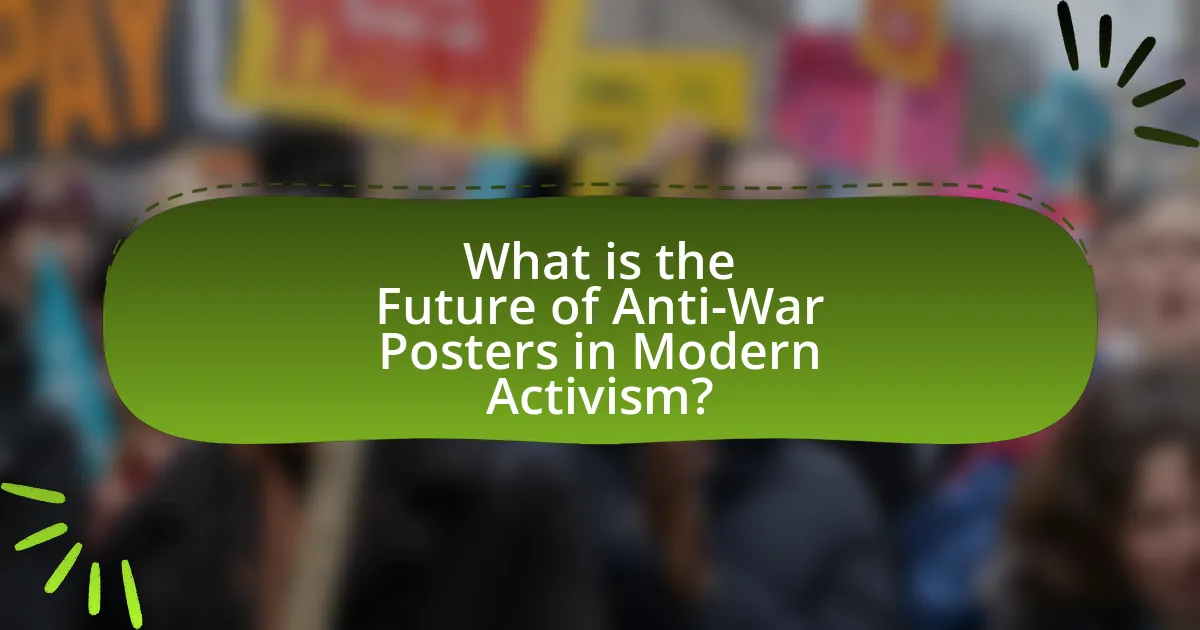
What is the Future of Anti-War Posters in Modern Activism?
The future of anti-war posters in modern activism is likely to be shaped by digital platforms and social media, which enhance their reach and impact. As traditional print media declines, activists are increasingly utilizing online channels to disseminate visual messages quickly and broadly, allowing for real-time engagement and feedback. For instance, during recent conflicts, hashtags and viral images have replaced physical posters, demonstrating a shift in how anti-war sentiments are expressed and shared. This evolution reflects a broader trend where visual activism adapts to technological advancements, ensuring that the core messages of peace and opposition to war remain relevant and accessible to diverse audiences.
How are digital platforms changing the landscape for anti-war activism?
Digital platforms are transforming anti-war activism by enabling rapid information dissemination and fostering global connectivity among activists. These platforms allow individuals and organizations to share messages, mobilize supporters, and organize events in real-time, significantly increasing the reach and impact of anti-war campaigns. For instance, social media platforms like Twitter and Facebook have been instrumental in organizing protests and spreading awareness about conflicts, as seen during the 2011 Arab Spring, where online activism played a crucial role in mobilizing public dissent against war and oppression. Additionally, digital platforms facilitate the creation and sharing of multimedia content, such as videos and infographics, which can effectively convey anti-war messages and engage a wider audience. This shift from traditional methods, such as printed posters, to digital formats reflects a significant evolution in how anti-war movements operate and communicate their messages.
What role do social media and online campaigns play in promoting anti-war messages?
Social media and online campaigns play a crucial role in promoting anti-war messages by providing platforms for widespread dissemination and engagement. These digital tools enable activists to reach global audiences quickly, facilitating the sharing of information, personal stories, and calls to action. For instance, during the Iraq War, social media platforms like Facebook and Twitter were instrumental in organizing protests and mobilizing support, as evidenced by the millions of users who participated in online campaigns such as “Not In Our Name.” This demonstrates that social media not only amplifies anti-war sentiments but also fosters community and solidarity among like-minded individuals, making it a powerful vehicle for social change.
How can traditional anti-war poster techniques be adapted for modern audiences?
Traditional anti-war poster techniques can be adapted for modern audiences by incorporating digital media and social platforms to enhance visibility and engagement. For instance, the bold graphics and emotive slogans used in historical posters can be transformed into shareable digital content, such as infographics or animated videos, which can reach a wider audience through social media channels. Additionally, modern anti-war campaigns can utilize interactive elements, such as augmented reality, to create immersive experiences that resonate with younger generations. Historical examples, like the iconic “Make Love, Not War” poster from the Vietnam War era, demonstrate the effectiveness of strong visual messaging, which can be reimagined in contemporary contexts to address current conflicts and social issues. By leveraging technology and current communication trends, traditional techniques can maintain their impact and relevance in today’s society.
What practical strategies can activists use to create impactful anti-war posters?
Activists can create impactful anti-war posters by utilizing clear messaging, strong visuals, and emotional appeal. Clear messaging involves using concise, powerful slogans that resonate with the audience, such as “War is Not the Answer,” which has historically proven effective in mobilizing public sentiment against conflict. Strong visuals, including striking imagery or symbols like peace signs, can capture attention and convey the message quickly, as seen in iconic posters from the Vietnam War era. Emotional appeal can be achieved through imagery that evokes empathy, such as photographs of war’s human cost, which can drive home the urgency of the anti-war message. These strategies have been validated by studies showing that visual and emotional elements significantly enhance the effectiveness of protest materials in influencing public opinion.
What design principles should be considered for effective messaging?
Effective messaging in design requires clarity, simplicity, and emotional resonance. Clarity ensures that the message is easily understood, while simplicity avoids overwhelming the audience with unnecessary details. Emotional resonance connects with viewers on a personal level, making the message more impactful. Research shows that designs that prioritize these principles can increase viewer engagement and retention of the message, as evidenced by studies on visual communication effectiveness. For instance, a study by Tufte (2001) highlights that clear and simple visuals enhance comprehension and recall, supporting the importance of these design principles in effective messaging.
How can activists engage communities through anti-war poster campaigns?
Activists can engage communities through anti-war poster campaigns by creating visually impactful and thought-provoking designs that resonate with local values and experiences. These posters can serve as conversation starters, prompting discussions about the implications of war and the importance of peace. Historical evidence shows that during the Vietnam War, for instance, posters effectively mobilized public sentiment against military involvement, leading to increased participation in protests and community organizing. By utilizing local imagery and language, activists can foster a sense of ownership and relevance, making the message more relatable and encouraging community members to take action.
